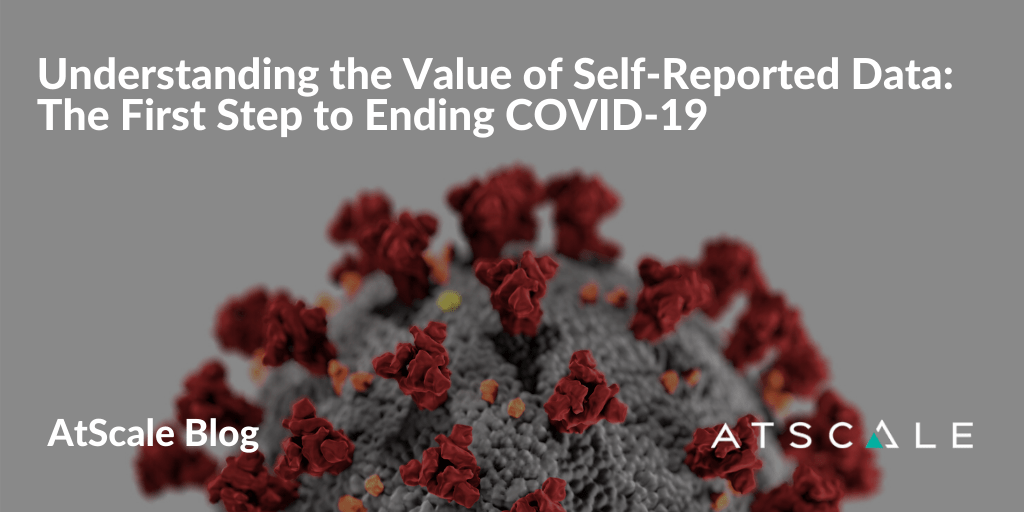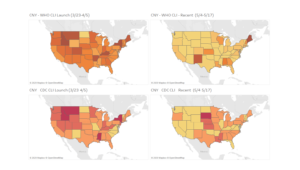August 18, 2020
Introducing AtScale 2020.3: Cloud OLAP Without “Owning” the Data
COVID-19 data is all around us. How are we to make sense of it? In our recent webinar with the experts from Boston Children’s Hospital, Harvard Medical School and Tableau, we shared how public health officials and policy makers are analyzing data to help end the pandemic. Using crowdsourced data from COVIDNearYou.org, thousands of reports in the United States are being reported and analyzed by experts in real-time. This article explains how we’re able to do it.
*This webinar is part of Tableau’s “Business Recovery Series,” where the focus is on showing how technology is working to get businesses back on their feet on the path towards a post COVID-19 world. The series speaks to different industries, with discussions on healthcare, supply chain management, credit risk, employee wellness, and marketing analytics.
What is “COVID Near You”?
COVIDNearYou.org is a project created by Boston Children’s Hospital and Harvard Medical School in direct response to COVID-19. The site helps researchers gain a better understanding of coronavirus in North America by encouraging the public to self report their data. The crowdsourced data helps researchers understand and detect who is being affected and where. Kara Sewalk, Project Manager at Boston Children’s Hospital, shares the origins of the project, citing FluNearYou.org as a sister project that began in 2012 to explore flu patterns with self-reported data. Sewalk later speaks on the importance of crowdsourced data in a means to detect early symptoms and make testing more accessible as “everyone in the field of public health and medicine is challenged with understanding the dynamics of this emerging disease.”
As of today, over 1,199,077 people have reported their data on the site, helping the Boston Children’s Hospital team and their technology partners reach their goal to keep our communities safe and find an end to COVID-19.
Working Together with AtScale
AtScale is proud to partner with Boston Children’s Hospital by allowing them to pull complex COVID-19 data into a single semantic model.
Daniel Gray, VP of Solutions Engineering at AtScale, speaks to the quality of the collected data, “The great thing about this data is that it’s really granular. It provides a lot of really great insights.” Gray shares how users can dive into the data by being able to“drill down by different topics,” that contribute to COVID-19 research such as people’s temperatures reported in particular zip codes, rashes, stomach aches, etc.
Leveraging AtScale’s Cloud OLAP technology, there is no data engineering or modeling required of the COVIDNearYou.org data. Gray demonstrates how we were able to turn the data into dimensions and hierarchies and make it “easily consumable with a tool like Tableau.”
Working Together with Tableau
With the power of Tableau, Christina Astley, Physician Scientist Instructor in Pediatrics at Boston Children’s Hospital and Harvard Medical School, shares the visualizations and speaks to the data that is collected. Astley recalls that the data is reflecting change, sharing how social distancing has influenced CLI reports of fevers and coughs have “declined dramatically” since the first visualization on March 23rd. Astley also states that the CLI definitions have “evolved over time as we’ve appreciated more and more about the biology physiology of COVID-19,” and now with more information we are moving from “a strict definition to a much broader definition, proposed by the CDC, which is, one major symptom or two minor symptoms.”

What does the “new normal” look like?
Want to learn how we’re navigating the “new normal” in a post COVID-19 world? Click here to get access to our current Cloud OLAP models. Interested in seeing how you can perform live, multidimensional analysis on COVID-19 datasets with popular BI tools? Watch our webinar here.
NEW BOOK